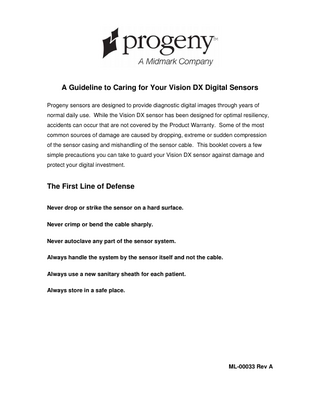Guide
3 Pages

Preview
Page 1
A Guideline to Caring for Your Vision DX Digital Sensors Progeny sensors are designed to provide diagnostic digital images through years of normal daily use. While the Vision DX sensor has been designed for optimal resiliency, accidents can occur that are not covered by the Product Warranty. Some of the most common sources of damage are caused by dropping, extreme or sudden compression of the sensor casing and mishandling of the sensor cable. This booklet covers a few simple precautions you can take to guard your Vision DX sensor against damage and protect your digital investment.
The First Line of Defense Never drop or strike the sensor on a hard surface. Never crimp or bend the cable sharply. Never autoclave any part of the sensor system. Always handle the system by the sensor itself and not the cable. Always use a new sanitary sheath for each patient. Always store in a safe place.
ML-00033 Rev A
Preventing Cable Damage Cable damage is the most common cause of sensor failure. Here are some easy steps to help protect your sensor cable and its connection: •
Do not pull on the cable to remove a used sanitary sheath
•
Do not bend the cable back tightly from the sensor
•
Never coil or wind the cable into sharp, tight loops
•
Do not hang the sensor by the cable
•
Make sure the sensor cable is kept off the floor where it could be stepped on or crushed by a stool or chair
Sensor Care – Storage There are several ways to store your sensor safely. Here are three recommended storage methods: •
Store the sensor in the safety case provided by Progeny
•
Store the sensor in the holder provided by Progeny
•
Store in a safe, dry place designated by your practice
Correct Sensor Sheath Use Applying a sensor sheath • Always hold the sensor by the edges •
Insert the sensor into the sheath, and gently push the cable until the sensor reaches the indented area of the sheath.
•
Hold the sensor with one hand and push the sheath down over the sensor with the index finger and thumb of your other hand.
•
Straighten the sensor sheath
Removing the sensor sheath • Grasp the sensor at the top •
Push the sheath up with the index finger and thumb of your other hand
•
With the sensor in your palm, slip the used sensor off and discard
Sensor Care -- Cleaning and Disinfection Always . . . 1. Use a new sanitary sensor sheath for each patient. Sensor sheaths protect both the patient and the sensor. Keeping the sensor in a sheath prevents damage to the sensor components from any possible fluid seepage.
2. Remove the sanitary sheath and disinfect the sensor after each use. Please note that some disinfectants, such as bleach or Lysol are not recommended for use with sensors. Disinfectants must be EPA Registered Hospital Grade Disinfectant.
3. Cleaning and Disinfection •
Remove the used sensor sheath
•
Gently wipe the sensor and the cable with a cloth moistened in water
•
Wipe the sensor and the cable with a clean cloth or gauze pad moistened with an EPA Hospital Approved Disinfectant
•
Sensor must remain wet for several minutes after application of the disinfectant and according to the manufacturer’s instructions.
•
DO NOT IMMERSE THE SENSOR IN THE DISINFECTANT
•
DO NOT SOAK THE SENSOR IN ANY LIQUID
•
For detailed information you may wish to read the JADA Guidelines for infection control in dental healthcare settings-2003, or other professionally published guidelines.
Never…. •
Never immerse or soak the sensor in any liquid
•
Never use any disinfectant not recommended by or approved by the EPA.
•
Never autoclave the sensor or any of its components
If you have additional questions about sensor care and handling, contact your dental equipment representative or call Progeny at 888-924-3800, Extension 2; or 847-4159800, Extension 2.
Copyright 2009 Progeny Dental – A Midmark Company
675 Heathrow Drive Lincolnshire IL 60069